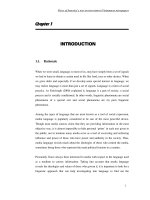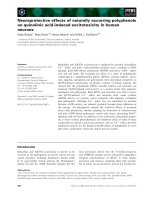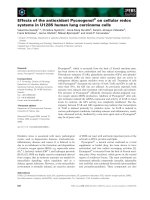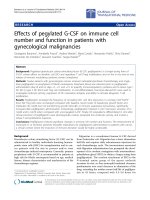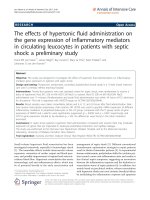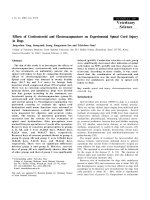Effects of eating dinner alone on overweight in Japanese adolescents: A cross-sectional survey
Bạn đang xem bản rút gọn của tài liệu. Xem và tải ngay bản đầy đủ của tài liệu tại đây (354.85 KB, 6 trang )
Shirasawa et al. BMC Pediatrics (2018) 18:36
/>
RESEARCH ARTICLE
Open Access
Effects of eating dinner alone on
overweight in Japanese adolescents: a
cross-sectional survey
Takako Shirasawa*, Hirotaka Ochiai, Takahiko Yoshimoto, Masaaki Matoba, Yuma Sunaga, Hiromi Hoshino
and Akatsuki Kokaze
Abstract
Background: The decrease in the frequency of family meals among Asian youth is often lamented. In Japan, adolescents
who eat breakfast alone might have an unhealthy diet, which increases the risk of overweight or obese. However, there
are few studies on the relationship between eating dinner alone and overweight in Japanese adolescents. Here, we
investigated if eating dinner alone is associated with being overweight in Japanese adolescents of each sex.
Methods: The participants consisted of 890 seventh graders (12–13 years of age) from the junior high schools of Ina,
Japan who were recruited from 2011 to 2012. Information about eating dinner alone was obtained using a self-reported
questionnaire, which was given to each participant. The participants were classified into the following three groups: does
not eat alone, eats alone 1–2 times/week, or eats alone ≥3 times/week. A logistic regression model was used to examine
the relationship between eating dinner alone and being overweight. The height and weight of each participant were
measured. Childhood overweight status was defined using the body mass index cutoff points proposed by the
International Obesity Task Force.
Results: When compared with girls who did not eat dinner alone, a significantly increased odds ratio (OR) was observed
among girls who ate dinner alone ≥1 time/week (adjusted OR = 2.78; 95% confidence interval = 1.21–6.38). In contrast,
there was no statistically significant difference between eating dinner alone and being overweight among boys.
Conclusion: The present study found that eating dinner alone is associated with being overweight among adolescent
girls in this community in Japan. Therefore, reducing the frequency of eating dinner alone might contribute to decreasing
the risk for becoming overweight or obese among adolescent girls.
Keywords: Eating dinner alone, Overweight, Adolescents, Japan
Background
Childhood obesity is one of the most serious public health
challenges of the twenty-first century [1], and the increase
in obesity is possibly associated with inappropriate dietary
habits [2]. Previously published studies report that eating
family meals together is a potential factor that may protect
against unhealthy eating and obesity during childhood and
adolescence [3–9]. Increasing the frequency of eating family
meals together may decrease the risk of overweight or
obese in children and adolescents [8]. A meta-analysis suggested that children and adolescents in families that share
* Correspondence:
Department of Public Health, Showa University School of Medicine, 1-5-8
Hatanodai, Shinagawa-ku, Tokyo 142-8555, Japan
≥3 family meals/week are 12% less likely to be overweight
in comparison with those who share < 3 family meals/week
[4]. A previous study reported that eating meals as a family
every day is associated with a lower rate of obesity, as well
as good lifestyle habits such as eating balanced meals [5].
Thus, the family meal is important for preventing overweight and obesity in children and adolescents.
However, a recent study showed a decrease in the frequency of family meals among Asian youth between 1999
and 2010 [10]. In Japan, Adachi reported that 12.6% of children eat their breakfast with all members of their family,
and this is a 10% decrease compared with a similar study
that was conducted approximately 20 years ago (in 1981)
[11, 12]. In addition, Adachi reported that 26.4% of children
© The Author(s). 2018 Open Access This article is distributed under the terms of the Creative Commons Attribution 4.0
International License ( which permits unrestricted use, distribution, and
reproduction in any medium, provided you give appropriate credit to the original author(s) and the source, provide a link to
the Creative Commons license, and indicate if changes were made. The Creative Commons Public Domain Dedication waiver
( applies to the data made available in this article, unless otherwise stated.
Shirasawa et al. BMC Pediatrics (2018) 18:36
eat breakfast alone, 24.5% eat with other children but no
adults, and these two groups combined showed a 12%
increase compared with results reported 20 years ago
[11, 12]. Moreover, the increase in the proportion of
children eating alone is often lamented in the popular
media in Japan [13].
Previous studies reported that adolescents who eat
breakfast alone tend to have a low intake of vegetables
and fish in their daily diet, thereby suggesting unhealthy
dietary habits [14, 15]. Therefore, adolescents who eat
breakfast alone might have an unhealthy diet, which increases the risk of overweight or obese. However, to the
best of our knowledge, there are few studies on the relationship between eating dinner alone and being overweight in Japanese adolescents [16, 17].
Accordingly, here we investigated if eating dinner
alone is associated with being overweight in Japanese adolescents of each sex. Our hypothesis was that a high
frequency of eating dinner alone would be associated
with being overweight in adolescent boys and girls.
Methods
Participants
In addition to the annual national health checkups that
are performed in accordance with the School Health
Law of Japan, the town of Ina in the Saitama Prefecture
of Japan runs a health promotion program as a part of
its community health services. As a part of this program,
a questionnaire survey and physical examinations are administered to seventh graders. The present study was
conducted as a part of this program.
The study participants in the present study consisted
of seventh graders (12–13 years of age) who were recruited from the junior high schools of the town of Ina,
Japan in 2011–2012 (n = 890). Written informed consent
was obtained from each child’s parent or guardian. The
Medical Ethics Committee of Showa University School
of Medicine approved the study protocol (No.127).
Questionnaire survey
The following information was obtained using a selfreported questionnaire that was given to each child: sex,
age, skipping breakfast (yes vs no), dinner time (regular vs
irregular), eats dinner alone (yes vs no), snacks after dinner
(yes vs no), eating speed (fast, medium, or slow), eats until
full (yes vs no), and sports teams’ participation (yes vs no).
Each participant’s parent or guardian was asked to
complete a self-administered questionnaire regarding the
number of siblings of each participant (only child vs ≥ 1 siblings) and paternal and maternal employment (yes vs no).
Eating dinner alone was assessed using the following
question on the self-administered questionnaire that was
given to each child: “Do you eat dinner alone?” If the
child answered “yes” to this question, the frequency of
Page 2 of 6
eating dinner alone was evaluated using the following
question: “How many times do you eat dinner alone during 1 week?” Based on these answers, we categorized the
participants into three groups: does not eat alone, eats
alone 1–2 times/week, or eats alone ≥3 times/week.
Anthropometric measurements
Measurements of the height and weight of each child
were performed annually during 2011–2012. The same
examination protocol was used annually to ensure uniform quality and precise assessments. For all measurements, all children were asked to remove their shoes
and socks, after which their height and weight were
measured in increments of 0.1 cm and 0.1 kg, respectively, while they were wearing light clothing. Body mass
index (BMI) was calculated as the participant’s body
weight (kg) divided by the square of their height (m2).
Childhood overweight status was defined using the BMI
cutoff points proposed by the International Obesity Task
Force (i.e., the age- and sex-specific cutoff points that
are linked to a BMI value of 25 at 18 years of age) [18].
The BMI cutoff points are based on average data collected from six countries (including Asian countries),
and these cutoff points were shown to be applicable to
Japanese children [19]. In the present study, the BMI
cutoff points for childhood overweight status were 21.22
(age 12) and 21.91 (age 13) for boys and 21.68 (age 12)
and 22.58 (age 13) for girls. For the purposes of the
present study, obese was included as overweight. Children who were not overweight were regarded as nonoverweight. Therefore, each participant in this study was
categorized into one of two weight status categories
(non-overweight vs overweight).
Statistical analysis
The unpaired t-test or chi-squared test was used to compare the characteristics between boys and girls. In the analysis stratified by sex, a logistic regression model was used
to examine the relationship between eating dinner alone
and being overweight. Because the proportions of overweight boys and girls who either ate alone ≥3 times/week
and 1–2 times/week were small, we combined these categories into a single category (eating dinner alone ≥1
time/week) and used propensity score adjustment in the
model. The propensity score is the conditional probability
of being exposed given the observed covariates [20, 21],
and propensity score adjustment preserves statistical
power by reducing covariates into a single variable [22]. In
this study, the observed covariates were age, being an only
child, paternal employment, maternal employment, sports
teams’ participation, skipping breakfast, dinner time,
snacking after dinner, eating speed, and eating until full,
which have been reported to related to being overweight
[19, 23]. In the model, crude odds ratios (ORs) and 95%
Shirasawa et al. BMC Pediatrics (2018) 18:36
Page 3 of 6
confidence intervals (CIs) for being overweight were first
estimated and subsequently adjusted for the propensity
score. In this study, P < 0.05 was considered statistically
significant. All data were analyzed using SPSS 20.0 J (IBM,
Chicago, Illinois, USA) and JMP Pro 13 (SAS Institute
Inc., Cary, North Carolina, USA).
Table 1 Characteristics of the study participants
Results
Among the 890 participants, 5 participants refused to
participate in the program (participation rate = 99.4%)
and 5 participants were excluded because of incomplete
data. Therefore, a total of 880 participants (470 boys and
410 girls) were analyzed in the present study.
The characteristics of the study participants (boys and
girls) are shown in Table 1. The proportion of overweight boys was significantly higher than among girls.
Although the proportion of participants who ate dinner
alone was 14.7% among boys (6.0% and 8.7% reported
eating alone ≥3 times/week and 1–2 times/week, respectively) and 10.8% among girls (4.9% and 5.9% reported eating alone ≥3 times/week and 1–2 times/week,
respectively), the difference in the proportions between
boys and girls did not reach a significant level. Moreover,
statistically significant differences between boys and girls
were observed in terms of maternal employment, sports
teams’ participation, dinner time, eating speed, and eating until full.
The characteristics of the overweight and the nonoverweight participants by sex are shown in Table 2. Statistically significant differences between the overweight
and the non-overweight participants were observed in
terms of the eating speed for each sex. The proportion
of participants who ate fast was higher in the overweight
group than in the non-overweight group regardless of
sex. Among boys, the proportion of participants who
were only children was higher in the overweight group
than in the non-overweight group. A statistically significant difference was not observed in terms of eating dinner alone between overweight and non-overweight boys.
In contrast, a statistically significant difference between
the overweight group and the non-overweight group was
found among the female participants who ate dinner
alone; the proportion of participants who ate dinner
alone in the overweight group was higher than in the
non-overweight group.
Next, the crude and adjusted ORs of eating dinner
alone for the overweight participants were calculated for
each sex, as shown in Table 3. When compared with
girls who did not eat dinner alone, a significantly increased OR was observed among the girls who ate dinner alone ≥1 time/week (adjusted OR = 2.78; 95% CI =
1.21–6.38). In contrast, there was no statistically significant difference between eating dinner alone and being
overweight among boys.
Actual weight status (%)
Boys (n = 470)
Girls (n = 410)
Pa
Age (years) (mean ± SD)
12.1 ± 0.3
12.1 ± 0.3
0.424
Height (cm) (mean ± SD)
151.9 ± 8.1
151.8 ± 5.9
0.764
Weight (kg) (mean ± SD)
42.9 ± 9.5
42.9 ± 8.1
0.887
BMI (kg/m2) (mean ± SD)
18.4 ± 2.9
18.6 ± 2.8
0.468
Overweight
15.7
10.0
0.012
Non-overweight
84.3
90.0
14.7
12.5
Variable
Only child (%)
0.335
Paternal employment (%)
93.6
95.1
0.348
Maternal employment (%)
65.9
72.1
0.049
< 0.001
Sports teams’ participation (%)
Yes
79.1
48.7
No
20.9
51.3
Skipping breakfast (%)
Yes
0.6
2.0
No
99.4
98.0
Regular
89.3
93.6
Non-regular
10.7
6.4
0.080
Dinner time (%)
0.023
Eats dinner alone (%)
None
85.3
89.3
1–2 /week
8.7
5.9
≥3 /week
6.0
4.9
0.192
Snacks after dinner (%)
Yes
49.4
52.6
No
50.6
47.4
Fast
23.2
13.4
Medium
59.9
62.1
Slow
16.8
24.4
Yes
70.7
64.4
No
29.3
35.6
0.342
Eating speed (%)
< 0.001
Eats until full (%)
0.047
SD standard deviation, BMI body mass index
a
Determined using the unpaired t-test or chi-squared test
Discussion
The present study shows that the proportions of children who eat dinner alone ≥3 times/week were 6.0%
among boys and 4.9% among girls. According to a survey of schoolchildren in Japan (performed in 2010), 6.0%
of junior high school children eat dinner alone ≥3 times/
week, which is similar to the results of our study [24].
Eating alone is believed to lead to unhealthy dietary
habits because such adolescents are not supervised by
their guardians and consequently often eat only the
foods they like [15]. Therefore, it is important to
Shirasawa et al. BMC Pediatrics (2018) 18:36
Page 4 of 6
Table 2 Characteristics of the non-overweight and the overweight participants by sex
Boys (n = 470)
Girls (n = 410)
Variable
Overweight
(n = 74)
Non-overweight
(n = 396)
Pa
Overweight
(n = 41)
Non-overweight
(n = 369)
Pa
Age (years) (mean ± SD)
12.1 ± 0.3
12.1 ± 0.3
0.383
12.1 ± 0.3
12.1 ± 0.3
0.688
Height (cm) (mean ± SD)
155.9 ± 7.9
151.2 ± 7.9
< 0.001
154.6 ± 4.7
151.5 ± 6.0
< 0.001
Weight (kg) (mean ± SD)
57.8 ± 8.7
40.1 ± 6.5
< 0.001
58.7 ± 7.6
41.2 ± 6.0
< 0.001
BMI (kg/m ) (mean ± SD)
23.7 ± 2.4
17.4 ± 1.6
< 0.001
54.5 ± 2.8
17.9 ± 1.9
< 0.001
Only child (%)
25.7
12.7
0.004
9.8
12.8
0.579
Paternal employment (%)
88.9
94.5
0.077
92.7
95.3
0.458
Maternal employment (%)
58.3
67.3
0.142
70.7
72.3
0.837
Yes
85.1
78.0
0.167
42.5
49.3
0.412
No
14.9
22.0
57.5
50.7
Yes
1.4
0.5
4.9
1.6
No
98.6
99.5
95.1
98.4
Regular
86.5
89.8
95.1
93.5
Non-regular
13.5
10.2
4.9
6.5
None
83.8
85.6
78.0
90.5
1–2 /week
10.8
8.3
9.8
5.4
≥ 3 /week
5.4
6.1
12.2
4.1
Yes
45.9
50.0
56.1
52.2
No
54.1
50.0
43.9
47.8
Fast
47.3
18.7
24.4
12.2
Medium
50.0
61.8
63.4
62.0
Slow
2.7
19.5
12.2
25.8
Yes
75.7
69.7
65.0
64.3
No
24.3
30.3
35.0
35.7
2
Sports teams’ participation (%)
Skipping breakfast (%)
0.401
0.153
Dinner time (%)
0.390
0.682
Eats dinner alone (%)
0.776
0.033
Snacks after dinner (%)
0.522
0.634
Eating speed (%)
< 0.001
0.032
Eating until full (%)
0.302
0.931
a
Determined using the chi-squared test
Table 3 Association between eating dinner alone and being overweight by sex
Eating dinner alone
Total
Overweight
Crude
N
n (%)
OR
Adjusteda
95% CI
OR
0.58–2.27
0.95
95% CI
Boys (n = 470)
None
401
62 (15.5)
1.00
≥ 1 /week
69
12 (17.4)
1.15
None
366
32 (8.7)
1.00
≥ 1/week
44
9 (20.5)
2.68
1.00
0.46–1.95
Girls (n = 410)
OR odds ratio, 95% CI 95% confidence interval
a
Adjusted for the propensity score
1.00
1.19–6.08
2.78
1.21–6.38
Shirasawa et al. BMC Pediatrics (2018) 18:36
consider eating alone as a serious health problem among
children and adolescents.
In this study, eating dinner alone was significantly associated with being overweight among girls. One explanation
for this result is that eating dinner alone might lead to unhealthy dietary habits, thereby resulting in being overweight.
Previous studies have reported that family meal times may
act as a protective factor against many nutritional healthrelated problems encountered during childhood and adolescence, including issues related to being overweight,
unhealthy eating, and disordered eating [4, 8]. In addition,
Feldman et al. reported that families who choose to eat together might be more likely to try to prepare well-balanced,
nutritious meals in comparison with adolescents who eat
on their own and may rely on prepackaged convenience
foods for meals, which often lack fruits and vegetables [25].
Therefore, our study findings suggest that eating dinner
alone leads to adolescents being overweight.
Furthermore, in the present study, we report the sex
differences among adolescents in terms of the association
between eating dinner alone and being overweight: compared with girls who did not eat dinner alone, those who
ate dinner alone ≥1 time/week were at a greater risk of being overweight, but there was no statistically significant
relationship between eating dinner alone and being overweight among boys. These results remained even after
propensity score adjustment. A previous study reported
that, among girls, the intake of food items such as fish and
vegetables significantly differed between those who always
ate dinner with their family and those who rarely ate dinner with their family, but among boys there was no significant difference in food intake depending on family eating
habits [26]. Neumark-Sztainer et al. suggested that regular
family meals during adolescence plays a protective role
against extreme weight control behaviors and disordered
eating behaviors in adolescent girls, but not boys [27].
Moreover, boys’ mothers tend to prepare meals for their
sons, and girls’ mothers usually encourage their daughters
to cook for themselves [26]. Therefore, when adolescent
boys and girls eat dinner alone, boys might eat meals prepared by their mothers, whereas girls might freely cook
their favorite menu items, thereby resulting in an unhealthy diet and eating behaviors. In this study, the proportion of participants who eat until full, which has been
reported to be associated with being overweight [28], was
significantly higher among girls who eat dinner alone
(50% and 55.0% of girls eat until full among girls who eat
dinner alone 1–2 times/week and ≥3 times/week, respectively) than in girls who do not eat dinner alone (33.6% of
girls who do not eat dinner alone also eat until they are
full) (P = 0.048; data not shown). Therefore, it could be
important to reduce the frequency of eating dinner alone
in order to promote healthy eating behaviors and prevent
overweight status among adolescents, especially girls.
Page 5 of 6
The present study also has some limitations. First, the
questionnaire used in our study was not validated. Therefore, to verify our study results, a validated questionnaire
should be used in future research. Second, this study did
not consider factors in the home environment such as
watching television during meals [8, 25]. For example,
watching television during family meals is associated with
poorer dietary quality among adolescents [25]. Therefore,
these factors could have affected our study findings. Third,
the participants in this study were seventh graders (12–
13 years of age) from a single town in Japan, which might
limit generalizability to other countries. Finally, the
present study could not determine a causal relationship
between eating dinner alone and being overweight because it was a cross-sectional study. Therefore, the possibility of reverse causality cannot be denied.
Conclusions
The present study found that eating dinner alone is significantly associated with being overweight among adolescent girls, but there was no statistically significant
relationship between eating dinner alone and being overweight among adolescent boys in this community in
Japan. Therefore, reducing the frequency of eating dinner alone might contribute to decreasing the risk for being overweight or obese among adolescent girls.
Abbreviations
BMI: Body mass index; CI: Confidence interval; OR: Odds ratio; SD: Standard
deviation
Acknowledgments
The authors would like to thank all of the study participants, their parents and
guardians, all members of the Board of Education of Ina Town, Saitama Prefecture,
and the Ina-machi Conference for the Promotion and Implementation of the
Childhood Lifestyle-Related Disease Prevention Examination (Chairman
Dr. Yoshihito Toriyama).
Funding
This study was supported in part by Grants-in-Aid from the Ministry of
Education, Culture, Sports, Science, and Technology of Japan (2013–2015,
no. 25350854).
Availability of data and materials
The data used in this study are not openly available because providing data to
other third-party individuals is not permitted by the Medical Ethics Committee
of Showa University School of Medicine.
Authors’ contributions
TS and HO planned this study. MM and YS improved this study in meaningful
ways. TS drafted this manuscript. TS, HO, and HH collected the data. HO
supervised the data collection. TS and TY contributed to the statistical analysis.
AK made substantial contributions to the study concept and manuscript
revision. All authors read and approved the final manuscript.
Ethics approval and consent to participate
The study protocol was approved by the Medical Ethics Committee of
Showa University School of Medicine (no. 127). Written informed consent to
participate in this study was obtained from each child’s parent or guardian.
Consent for publication
Not applicable.
Shirasawa et al. BMC Pediatrics (2018) 18:36
Competing interests
The authors declare that they have no competing interests.
Publisher’s Note
Springer Nature remains neutral with regard to jurisdictional claims in
published maps and institutional affiliations.
Received: 30 May 2017 Accepted: 30 January 2018
References
1. WHO: Childhood overweight and obesity. 2017. />dietphysicalactivity/childhood/en/. Accessed 27 May 2017.
2. Miyoshi M, Tsuboyama-Kasaoka N, Nishi N. School-based "Shokuiku"
program in Japan: application to nutrition education in Asian countries. Asia
Pac J Clin Nutr. 2012;21(1):159–62.
3. Gable S, Chang Y, Krull JL. Television watching and frequency of family
meals are predictive of overweight onset and persistence in a national
sample of school-aged children. J Am Diet Assoc. 2007;107(1):53–61.
4. Hammons AJ, Fiese BH. Is frequency of shared family meals related to the
nutritional health of children and adolescents? Pediatrics. 2011;127(6):
e1565–74. />5. Yuasa K, Sei M, Takeda E, Ewis AA, Munakata H, Onishi C, Nakahori Y. Effects
of lifestyle habits and eating meals together with the family on the
prevalence of obesity among school children in Tokushima, Japan: a crosssectional questionnaire-based survey. J Med Investig. 2008;55(1–2):71–7.
6. Horning ML, Fulkerson JA, Friend SE, Neumark-Sztainer D. Associations
among nine family dinner frequency measures and child weight, dietary,
and psychosocial outcomes. J Acad Nutr Diet. 2016;116(6):991–9.
7. Fulkerson JA, Larson N, Horning M, Neumark-Sztainer D. A review of
associations between family or shared meal frequency and dietary and weight
status outcomes across the lifespan. J Nutr Educ Behav. 2014;46(1):2–19.
8. Martin-Biggers J, Spaccarotella K, Berhaupt-Glickstein A, Hongu N, Worobey
J, Byrd-Bredbenner C. Come and get it! A discussion of family mealtime
literature and factors affecting obesity risk. Advances in nutrition (Bethesda,
Md). 2014;5(3):235–47.
9. Valdes J, Rodriguez-Artalejo F, Aguilar L, Jaen-Casquero MB, RoyoBordonada MA. Frequency of family meals and childhood overweight: a
systematic review. Pediatr Obes. 2013;8(1):e1–e13.
10. Neumark-Sztainer D, Wall M, Fulkerson JA, Larson N. Changes in the frequency
of family meals from 1999 to 2010 in the homes of adolescents: trends by
sociodemographic characteristics. J Adolesc Health. 2013;52(2):201–6.
11. Adachi M. Project member of NHK Program. Naze Hitoride Taberuno (Why
do you eat alone?). Tokyo: Japan Broadcast Publishing; 1983. (in Japanese)
12. Adachi M. Project member of NHK Program. Shitteimasuka Kodomotachino
Shokutaku (Do you know about children's meal?). Tokyo: Japan Broadcast
Publishing; 2000. (in Japanese)
13. Takimoto H, Sarukura N, Ishikawa-Takata K. How to define family meals in
"Shokuiku" (food and nutrition education). J Nutr Sci Vitaminol (Tokyo).
2015;61(Suppl):S10–2.
14. Adachi M. Theories of nutrition education and promotion in Japan:
enactment of the "food education basic law". Asia Pac J Clin Nutr. 2008;
17(Suppl 1):180–4.
15. Sugiyama S, Okuda M, Sasaki S, Kunitsugu I, Hobara T. Breakfast habits
among adolescents and their association with daily energy and fish,
vegetable, and fruit intake: a community-based cross-sectional study.
Environ Health Prev Med. 2012;17(5):408–14.
16. Ainuki T, Eto K. Associations of family meal practices with health status and
dietary intake: a literature review using Japanese journal databases (in
Japanese). JJHEP. 2015;23:279–89.
17. Eto K, Ainuki T. Associations of family meal practices with health status and
dietary intake: a literature review using a foreign journal database (in
Japanese). JJHEP. 2015;23:71–86.
18. Cole TJ, Lobstein T. Extended international (IOTF) body mass index cut-offs
for thinness, overweight and obesity. Pediatr Obes. 2012;7(4):284–94.
19. Sun Y, Sekine M, Kagamimori S. Lifestyle and overweight among Japanese
adolescents: the Toyama birth cohort study. J Epidemiol. 2009;19(6):303–10.
20. Austin PC. An introduction to propensity score methods for reducing the
effects of confounding in observational studies. Multivar Behav Res. 2011;
46(3):399–424.
Page 6 of 6
21. Hade EM, Lu B. Bias associated with using the estimated propensity score as
a regression covariate. Stat Med. 2014;33(1):74–87.
22. Devasia RA, Blackman A, Gebretsadik T, Griffin M, Shintani A, May C, Smith T,
Hooper N, Maruri F, Warkentin J, et al. Fluoroquinolone resistance in
mycobacterium tuberculosis: the effect of duration and timing of
fluoroquinolone exposure. Am J Respir Crit Care Med. 2009;180(4):365–70.
23. Wang H, Sekine M, Chen X, Kanayama H, Yamagami T, Kagamimori S. Sibsize, birth order and risk of overweight in junior high school students in
Japan: results of the Toyama birth cohort study. Prev Med. 2007;44(1):45–51.
24. National agency for the advancement of sports and health. Report on the
children/students dietary situation survey. Tokyo: NAASH; 2010. (in Japanese)
25. Feldman S, Eisenberg ME, Neumark-Sztainer D, Story M. Associations
between watching TV during family meals and dietary intake among
adolescents. J Nutr Educ Behav. 2007;39(5):257–63.
26. Kusano-Tsunoh A, Nakatsuka H, Satoh H, Shimizu H, Sato S, Ito I, Fukao A,
Hisamichi S. Effects of family-togetherness on the food selection by primary
and junior high school students: family-togetherness means better food.
Tohoku J Exp Med. 2001;194(2):121–7.
27. Neumark-Sztainer D, Eisenberg ME, Fulkerson JA, Story M, Larson NI. Family
meals and disordered eating in adolescents: longitudinal findings from
project EAT. Arch Pediatr Adolesc Med. 2008;162(1):17–22.
28. Maruyama K, Sato S, Ohira T, Maeda K, Noda H, Kubota Y, Nishimura S,
Kitamura A, Kiyama M, Okada T, et al. The joint impact on being overweight
of self reported behaviours of eating quickly and eating until full: cross
sectional survey. BMJ. 2008;337:a2002.
Submit your next manuscript to BioMed Central
and we will help you at every step:
• We accept pre-submission inquiries
• Our selector tool helps you to find the most relevant journal
• We provide round the clock customer support
• Convenient online submission
• Thorough peer review
• Inclusion in PubMed and all major indexing services
• Maximum visibility for your research
Submit your manuscript at
www.biomedcentral.com/submit

